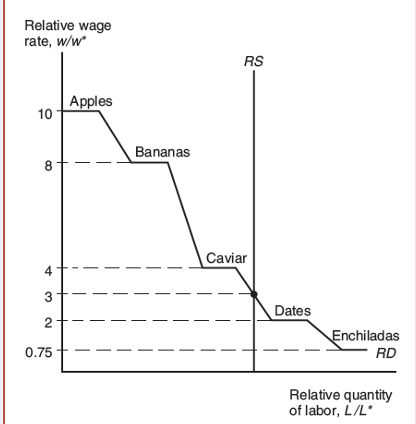Chapter 3 (everything but emperical evidence)
5.0(2)
5.0(2)
Card Sorting
1/30
Earn XP
Description and Tags
Study Analytics
Name | Mastery | Learn | Test | Matching | Spaced |
|---|
No study sessions yet.
31 Terms
1
New cards
Comparative advantage
the ability of one producer of a good (country) to produce at a lower opportunity cost than another producer (country) - this allows gain from trade
2
New cards
Gains from trade
the improvement in outcomes that occurs when producers specialize and trade goods instead of staying in autarky
By trading, countries can consume the other good they don't have a comparative advantage in cheaper than producing at home
By trading, countries can consume the other good they don't have a comparative advantage in cheaper than producing at home
3
New cards
Unit labour requirement
The amount of labour required to produce one unit of the good (aL_i)
aLi is the inverse of productivity. If a worker can produce 3 units of a good in one hour, the productivity is 3, but the aLi=1/3, as it takes 1/3 of an hour to produce of unit of the good
aLi is the inverse of productivity. If a worker can produce 3 units of a good in one hour, the productivity is 3, but the aLi=1/3, as it takes 1/3 of an hour to produce of unit of the good
4
New cards
Opportunity Cost
The trade-off when producing one good instead of another
The units of labour required to produce one unit of a good in terms of the labour required to produce another good
The units of labour required to produce one unit of a good in terms of the labour required to produce another good

5
New cards
Production possibilities
An economy has scarce resources and can only produce a finite amount of goods. If it produces one more unit of one good, it will have to give up an amount of units of another good.
6
New cards
Production Possibility Frontiers (PPF)
(in this example from the foreign perspective)

7
New cards
Total resources in a one factor economy
The total labour supply, given by L
8
New cards
The PPF equation (how to rearrange the PPF inequality )
The items in red are the calculations
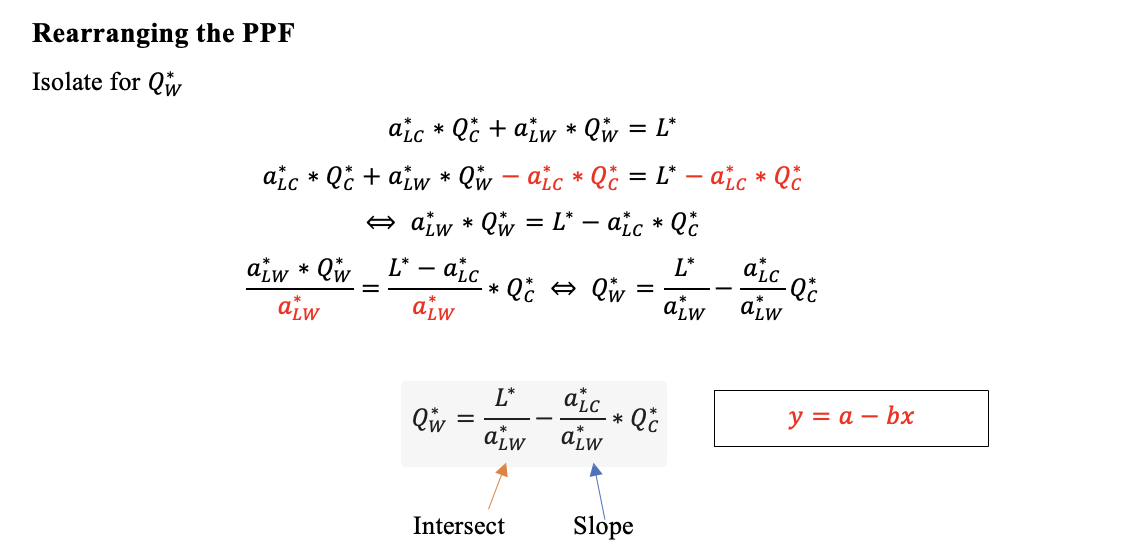
9
New cards
When the PPF is linear
The opportunity cost of producing one good in terms of the other is constant
10
New cards
The slope of the PPF
The absolute value is equal to the opportunity cost
11
New cards
Relative price
The price of one good in terms of the price of the other good
12
New cards
free labour mobility
labour will shift to the industry that has the highest wage and the economy will specialise in that good
13
New cards
wages, w_i
Generally, the price of the good/the unit labour requirements
In autarky, wages=price of the good. there's no profit in autarky
In autarky, wages=price of the good. there's no profit in autarky
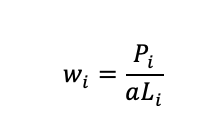
14
New cards
The relationship between prices and production
The economy will specialise in the production of Good Y if the relative price of Good Y exceeds its opportunity cost in terms of good X. It will specialise in Good X if the if the relative price of Good Y is less than its opportunity cost of Good Y in terms of Good X
15
New cards
Prices in autarky

16
New cards
Absolute advantage
When one country produce a good with less labour than the other country
- simply compare the unit labour requirements of each good in both countries
- simply compare the unit labour requirements of each good in both countries
17
New cards
Intersects on the axis of the PPF
If the country only produced one of the goods
L/aL_i and L/aL_x
L/aL_i and L/aL_x

18
New cards
General equilibrium analysis
Considers linkages between two markets (Comparative advantage models)
19
New cards
Relative Demand (RD)
Shows the demand for Good X in relation to Good Y
20
New cards
Relative Supply (RS)
The curve has steps and a vertical section.
Lower flatter section - Home can produce any amount of good with comparative advantage within constraints, but Foreign only produces the good they have a comparative advantage in
Vertical section - Between these two relative prices (OCs), both countries specialise (full utilisation)
Higher - Home produce only the goods they have a comparative advantage in; Foreign produces any amount of their good within their resource constraint
Lower flatter section - Home can produce any amount of good with comparative advantage within constraints, but Foreign only produces the good they have a comparative advantage in
Vertical section - Between these two relative prices (OCs), both countries specialise (full utilisation)
Higher - Home produce only the goods they have a comparative advantage in; Foreign produces any amount of their good within their resource constraint
21
New cards
Equilibrium
Where RD=RS
22
New cards
Free trade and consumption
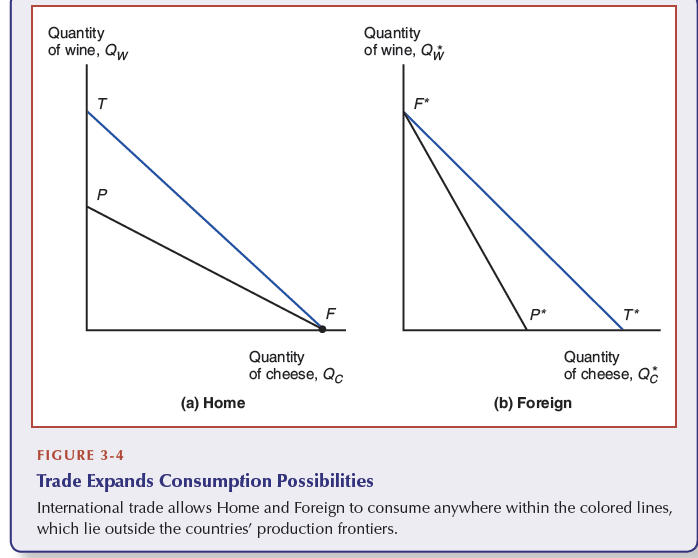
23
New cards
Relative wages
One will have to compare relative unit labour requirements and relative wages in order to figure out what country will produce what
e.g., if the relative wage is 3 times higher in one country but they are not 3 times more effective in producing the good, the other country will have the comparative advantage
e.g., if the relative wage is 3 times higher in one country but they are not 3 times more effective in producing the good, the other country will have the comparative advantage
24
New cards
Myth: Free trade is only beneficial if your country is strong enough to stand up to foreign competition
The idea of Ricardo's comparative advantage model is not absolute advantage, but specialising in the good that your country produces more efficiently than your trading country.
25
New cards
Pauper labour argument
An argument that builds on the notion that " Foreign competition is unfair and hurts other countries when it is based on low wages"
- comparative advantage → what are differences in efficiency? Can our country produce it cheaper than foreign or should we import and specialise in the good we can export at a higher price?
- comparative advantage → what are differences in efficiency? Can our country produce it cheaper than foreign or should we import and specialise in the good we can export at a higher price?
26
New cards
Comparative advantage with many goods
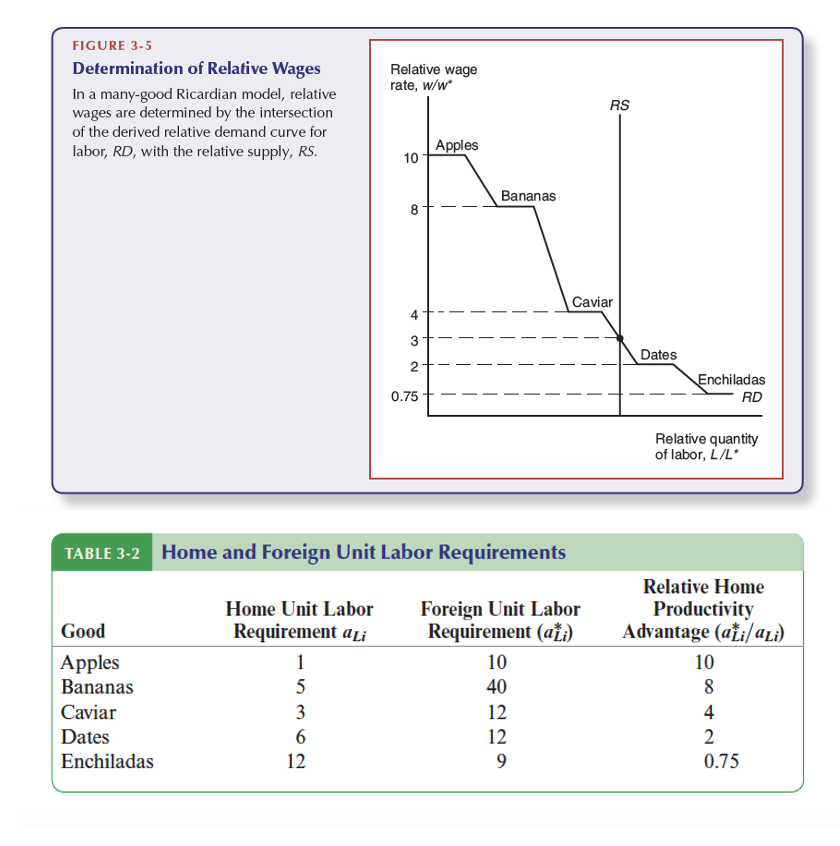
27
New cards
Trade with many goods
Compare the w/w* and the a*Li/aLi - Home will export the goods where w/w*
28
New cards
Relative Supply (Multigood)
Is determined by the relative size of labour forces L/L*
Vertical line
Vertical line
29
New cards
Relative Demand (Multigood)
Stepped curve
Whenever the relative wages, w/w*, Home's relative demand for labour will decrease (now more expensive) and demand for goods produced at home will decrease. Now relatively cheaper to produce at foreign.
Home will export the goods where w/w*
Whenever the relative wages, w/w*, Home's relative demand for labour will decrease (now more expensive) and demand for goods produced at home will decrease. Now relatively cheaper to produce at foreign.
Home will export the goods where w/w*
30
New cards
Flat section of the multigood model
The flat areas correspond to relative wages that equal the ratio of Home to Foreign productivity of the goods
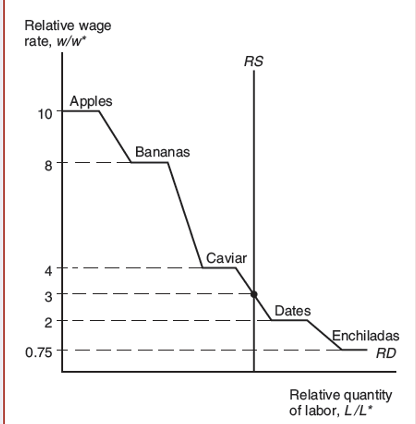
31
New cards
Multigood Equilibrium
RD=RS
In the example RD=RS=3 - Home will produce everything to the left and Foreign everything to the right of the RS line
IF RD=RS is at a flat point, both countries will produce that one good and the other goods as stated above
In the example RD=RS=3 - Home will produce everything to the left and Foreign everything to the right of the RS line
IF RD=RS is at a flat point, both countries will produce that one good and the other goods as stated above
